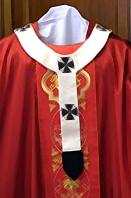

Q. 1. What is a Pallium and what is it used for?
A. 1. The modern pallium is a circular band about two inches wide, worn about the neck, breast, and shoulders, and having two pendants, one hanging down in front and one behind. The pendants are about two inches wide and twelve inches long, and are weighted with small pieces of lead covered with black silk. The remainder of the pallium is made of white wool, part of which is supplied by two lambs presented annually as a tax by the Lateran Canons Regular to the Chapter of St. John on the feast of St. Agnes, solemnly blessed on the high altar of that church after the pontifical Mass, and then offered to the pope. The ornamentation of the pallium consists of six small black crosses, one each on the breast and back, one on each shoulder, and one on each pendant. The crosses on the breast, back, and left shoulder are provided with a loop for the reception of a gold pin set with a precious stone. The pallium is worn over the chasuble.
The use of the pallium is reserved to the pope and archbishops, but the latter may not use it until, on petition they have received the permission of the Holy See. Bishops sometimes receive the pallium as a mark of special favour, but it does not increase their powers or jurisdiction nor give them precedence. The pope may use the pallium at any time. Others, even archbishops, may use it only in their respective dioceses, and there only on the days and occasions designated in the "Pontificale" (Christmas, the Circumcision, and other specified great feasts; during the conferring of Holy orders, the consecration of abbots, etc.), unless its use is extended by a special privilege.
Worn by the pope, the pallium symbolizes the plenitudo pontificalis officii (i.e. the plenitude of pontifical office); worn by archbishops, it typifies their participation in the supreme pastoral power of the pope, who concedes it to them for their proper church provinces.
An archbishop, therefore, who has not received the pallium may not exercise any of his functions as metropolitan, nor any metropolitan prerogatives whatever; he is even forbidden to perform any episcopal act until invested with the pallium. Similarly, after his resignation, he may not use the pallium; should he be transferred to another archdiocese. He must again petition the Holy Father for the pallium.